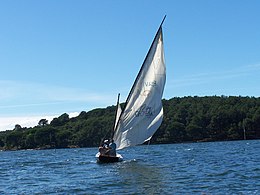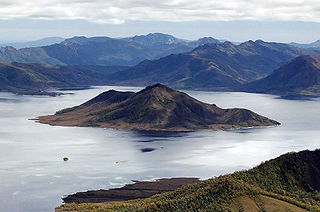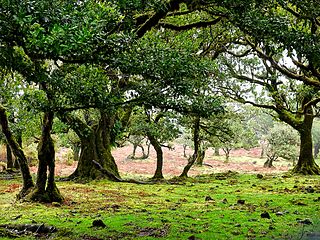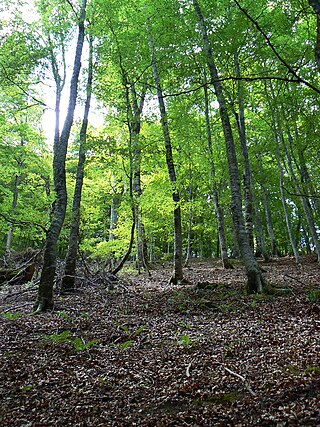Ecology
Cortegada island is valued by many researchers and scientists, as well as by the richness of its sea, for having on its north side the largest forest of bay laurel that exists in Europe. Ligustrum, Buxus, and bitter orange are some other species on Cortegada with laurel tree shape. From a distance, the island appears to be completely covered with dense woodland; it is renowned for having the last wild laurel forest of Galicia as well as a mixed population of stone pine ( Pinus pinea ) and maritime pine ( Pinus pinaster ), and a large oak forest with Quercus robur , Quercus suber , and Quercus pyrenaica . This forest formerly covered much of the coast and coastal mountains of the mainland surrounding and other Atlantic islands in the area with locally favourable wet climate microenvironments, but those forests have been much reduced in extent by logging, clearance for agriculture and grazing, and the invasion of exotic species.
The type forests are made up of laurel-leaved evergreen hardwood trees, reaching up to 40 m in height when older. Many of the species are endemic to islands, and harbour a rich biota of understorey plants, invertebrates, some species of lizards ( Lacerta lepida , Podarcis bocagei , Chalcides striatus ), slowworms ( Anguis fragilis ), and snakes, ( Elaphe scalaris , Coronella girondica , Natrix maura ). The island has some goats and wild boars ( Sus scrofa ), wild horses lived there until recently ( Crocidura russula , Erinaceus europaeus , Talpa occidentalis ), bats ( Pipistrellus pipistrellus , Eptesicus serotinus , Rhinolophus ferrumequinum ), feral cats (Felix catus), feral mink ( Mustela vison ), rabbits, mice, rats and birds such as Iberian chiffchaff, the coal tit, the great tit, woodpecker, Eurasian wryneck, collared dove, common wood pigeon, blackbird, Scolopax rusticola , greenfinch, warbler, finch, saithe, stonechat, robin, goldfinch, wagtail, black redstart, buzzard, goshawk, and peregrine falcon. Besides many seabirds species such as cormorants and shorebirds take refuge on the island and several species of gulls nest in the breeding season.
The scrubland is formed mainly of autochthonous species, like gorse, broom, spurge flax ( Thymelaea ), rockrose (Cistaceae), sea pink ( Armeria maritima ), spiny thrift ( Armeria pungens ), Corema album, etc. Typically the marshland flora like rushes and other grow in the area of the lagoon and the ponds.
The woodland supports a diverse understorey of ferns such as Davallia canariensis (a Macaronesian epilithic fern species) and bryophytes, which require moisture for reproduction, this vegetation besides cover the ruins of the old stone houses with mosses, lichens and creepers. There are numerous herbaceous plants such as genus Sedum , Teucrium scorodonia , stinking iris ( Iris foetidissima ), Xolantha guttata , Melissa officinalis , Symphytum officinalis , Vinca difformis , Aeonium sp., Hyacinthoides sp. etc. and several species of grasses. [2]
Some evergreen climbing plants like asparagus species and Araliaceaes as Hedera helix , or Hedera iberica . Various feral fruit trees species occur, such as apple, plum and pear trees, Citrus aurantium , Vitis vinifera , common fig, hazelnut, walnut, Chesnut. The trees Salix atrocinerea , Alnus glutinosa , Platanus × hispanica Populus nigra , Ulmus, and allochthonous Cupressaceae are widespread, as are the bird-dispersed shrubs Ligustrum , honeysuckle Lonicera periclymenum , Prunus lusitanica , Prunus spinosa , Crataegus monogyna , Sorbus , Buxus , Osyris , European Mistletoe, Cornus, Taxus baccata , Ulex europaeus subsp. latebracteatus, Rubus ulmifolius, Tamus communis, and Ilex aquifolium . There are two constituent species in the genus Laurus Laurus nobilis and Laurus azorica known as Azores Laurel, a native to the laurel forests of the Azores, was also locally introduced in Cortegada Island. These recent forest are young yet with trees 18–20 m tall following the eviction of the last inhabitants. Ferns, liverworts, mosses and lichens grow up the trunks and branches. Creepers and vines complete the tangle.
A recent study found considerable genetic diversity within L. nobilis, and that L. azorica is not genetically or morphologically distinct. [3] This populations like the Cortegada Island population, famous for its large grove of laurels, come from seeds dispersed by birds but is not indigenous to the island, as this islander forest originated spontaneously from laurel specimens that were planted after the original vegetation was destroyed. The location of the Islands in the North Atlantic Ocean maintained the humid and relatively mild climate which has allowed these forests to persist to the present day, although autochthonous vegetation was almost entirely cleared for orchards, wheat fields, subsistence crops and exotic timber plantations of eucalyptus, mostly Eucalyptus globulus, pine and oak in the past. The forest regenerated easily, its decline was due to the tremendous pressure it supported.
The most common epilithic plants are Umbilicus rupestris and the ferns Polypodium interjectum and Davallia canariensis. [2] The willows are very numerous and the laurels of Cortegada live in the soils with standing water. The understorey of these Laurel forest is low, falling almost to the ground lined with ivy, along with some wood-sage plants ( Teucrium scorodonia ) and snakeroot ( Arisarum vulgare ). Willows ( Salix atrocinerea ) occupy the eastern part of the island in permanently or temporarily waterlogged soils as the only tree species, mono-specific forest, and on the west side are mixed with alder ( Alnus glutinosa ). The Marsh Vegetation provides food for the large herbivores. [2]



























